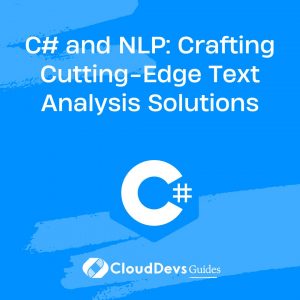C# and NLP: Crafting Cutting-Edge Text Analysis Solutions
Table of Contents
Natural Language Processing (NLP) is a field at the intersection of computer science, artificial intelligence, and linguistics. It focuses on enabling computers to understand, interpret, and manipulate human language. With the rise of big data and the need for data-driven decision-making, NLP has become more critical than ever. In this post, we’ll explore how C#, a powerful programming language, can be utilized for NLP to analyze text data. You can hire C# developers for your projects to ensure greater success.

Table of Contents
1. Why C# for NLP?
C# is a versatile language known for its strong typing, imperative, declarative, functional, generic, object-oriented, and component-oriented programming disciplines. Its rich library and framework support, particularly with .NET, make it an excellent choice for NLP tasks. A key advantage of using C# for NLP is its efficiency in handling large datasets and complex algorithms, which are common in text analysis.
2. Getting Started with NLP in C#
To start with NLP in C#, one needs to understand the basics of text processing. This includes text normalization, tokenization, and part-of-speech tagging. Microsoft’s .NET platform offers several libraries for these purposes, such as the Stanford NLP for .NET (see Stanford NLP).
Example 1: Sentiment Analysis
Sentiment analysis is a common NLP task that involves determining the emotional tone behind a body of text. This is incredibly useful in social media monitoring, market research, and customer service. In C#, this can be implemented using machine learning libraries such as ML.NET. ML.NET is a cross-platform, open-source machine learning framework (refer to ML.NET Documentation).
Here’s a basic example:
```csharp
using Microsoft.ML;
using Microsoft.ML.Data;
public class SentimentData
{
[LoadColumn(0)]
public string SentimentText;
[LoadColumn(1), ColumnName("Label")]
public bool Sentiment;
}
// ... Load data, train model
```
This code snippet demonstrates the initial setup for a sentiment analysis model using ML.NET.
Example 2: Text Classification
Text classification involves categorizing text into organized groups. Using C#, this can be done by training a model on a dataset using ML.NET. For instance, classifying news articles into categories like sports, politics, and technology.
3. Advanced NLP Techniques
For more advanced NLP tasks, such as Named Entity Recognition (NER) or language understanding, one might integrate C# applications with cloud-based services like Azure Cognitive Services (explore Azure Cognitive Services). These services provide pre-trained models that can be fine-tuned for specific tasks.
5. Challenges and Considerations
While C# is powerful for NLP, there are challenges. One must be mindful of the complexity of human language – idioms, sarcasm, and varying dialects. Moreover, handling large datasets requires efficient memory management.
Conclusion
C# offers a robust and efficient way to handle NLP tasks. Whether you’re working on sentiment analysis, text classification, or advanced NLP, C# combined with .NET libraries and cloud services provides a solid foundation. As with any language processing task, the key is to understand the nuances of the language and have a clear goal in mind.
Remember, the field of NLP is constantly evolving. Stay updated with the latest trends and advancements to make the most out of your text analysis endeavors.
You can check out our other blog posts to learn more about C#. We bring you a complete guide titled An Introductory Guide to the Fundamentals of C# Programming along with the Leveraging the Power of Entity Framework for Efficient Database Operations in C# and Advanced C# Programming Techniques which will help you understand and gain more insight into the C# programming language.



